Artists who garner the most attention in any given time period are those whose work, explicitly or implicitly, reflects the deeper political sensibilities of the era. Right now, contemporary artists to watch are those who have turned away from the traditional egocentric focus and embraced the communitarianism associated with Barack Obama’s campaign and now with his administration. Artists who project a me-me-me attitude and are consumed with obsessive careerism look shabby and regressive. While the art world rallied around commerce in the Bush years, it may zone in on community in the Obama epoch. Despite the demoralizing art market downturn, the art world has been infected with President Obama’s inclusive “Yes We Can” spirit, finally catching up with the small cadre of artists and art bloggers who were the first to adopt decentralized, community-minded art practices that fully embraced American pragmatism and ingenuity. If this shift is any indication, generosity may be the defining value of the new era. Here are a few of the artists who exemplify the shift from an inward to an outward focus.
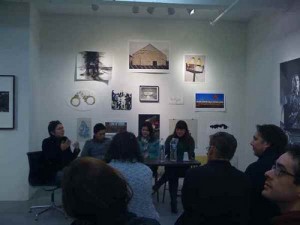
In January, Chan, second from left, participated in an informal gallery talk with members of New Orleans art collective The Front. (Photo: Hrag Vartanian)
Paul Chan
With funding from Creative Time, Paul Chan went to New Orleans and staged Waiting for Godot in New Orleans. The project evolved into a larger social production involving free art seminars, educational programs, theater workshops, and conversations with the community. As a result of Chan’s seminars and workshops, several artists organized ongoing collective projects. In January, one of the collectives, The Front, was invited to participate in Things Fall Apart, an exhibition at Edward Winkleman Gallery, curated by artist/blogger Joy Garnett. “It is fashionable today (still?) to claim that there is nothing new beyond our horizon of art, that everything worth doing has been done, “ Chan said in his project statement for Godot. “But this seems to me an altogether specious claim, for it ignores the vast undiscovered country of things that ought to be undone. In these great times, the terror of action and inaction shapes the burden of history. Perhaps the task of art today is to remake this burden anew by suspending the seemingly inexorable order of things (which gives the burden its weight) for the potential of a clearing to take place, so that we can see and feel what is in fact worthless, and what is in truth worth renewing.”
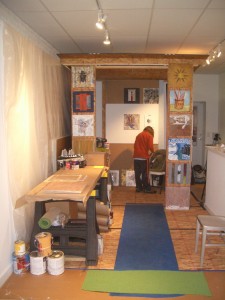
“Habitat For Artists Goes Indoors” is on view through Feb. 28. Draper built a replica of one of the sheds so visitors could sit in it and appreciate the small spaces.
Simon Draper: Habitat for Artists
Using reclaimed materials, Simon Draper created a makeshift community of studio sheds in Beacon, NY, and invited artists to use them for the summer. He and co-organizer Amy Lipton, curator for ecoartspace, a New York- and California-based non-profit organization dedicated to raising environmental awareness through the arts, encouraged each artist to adapt their shack, initially outfitted with simple openings, doors, windows, or skylights to suit their own needs. This month, Draper, Lipton, and their band of collaborators brought the project inside to Van Brunt Gallery in Beacon, NY, where artists are using the gallery as studio space, offering workshops, organizing panel discussions, and sharing their art making practices with the general public.
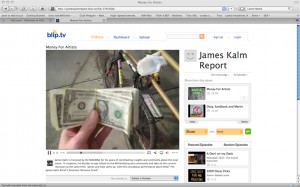
Kalm Report on Blip.tv
Loren Munk: James Kalm Report
Loren Munk is the mastermind behind the James Kalm Report, a video chronicle of the contemporary New York art scene. Munk, a painter himself, bikes to art shows, tiny videocam in hand, interviewing both famous artists and friends at openings around the city. Each video, featuring Munk’s stage-whispered narration, is edited and posted on BlipTV free of charge. Munk’s commitment to the local art community also includes “Brooklyn Dispatches,” a monthly column in the artist-run art journal, The Brooklyn Rail. When Munk was honored by WagMag (Williamsburg and Greenpoint Monthly Art Guide) for his contributions to the local art community, he turned the event into a conceptual performance project called “The James Kalm Artist’s Economic Stimulus Grant,” giving everyone in the audience a dollar.
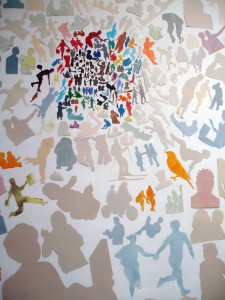
“Prototypes,” a wall installation of Simon’s acetate stencils at Pocket Utopia. The solo show is on view March 7-April 12, 2009.
Adam Simon: Fine Art Adoption Network
Adam Simon keeps a deliberately open focus between his painting and public projects, one of which is the Fine Art Adoption Network. Recognizing that many of the projects artists create end up in storage, Simon started FAAN as a way to place artworks by committed artists into appreciative homes and institutions. Since its inception in 2005, FAAN has enabled both emerging and established artists to connect with new art audiences. In March Pocket Utopia (see below) will feature an exhibition of Simon’s paintings, as a well as hosting discussions about FAAN and his other projects, all of which were conceived as a way to link people with one another.
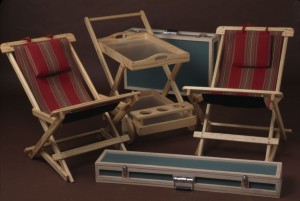
Austin Thomas, “Open and Shut Case,” 2004. Suitcases, chairs, and BBQ chart, Wood, plexiglas, cloth, chalk board. Currently on view in “Out of The Blue,” curated by Amy Lipton, Joy Episalla, and Joy Garnett. Gallery Bergen, Bergen Community College, Paramus, NJ. On view through April 17.
Austin Thomas: Pocket Utopia
For several years artist Austin Thomas, interested in how we fill space and interact with other people, adapted her artmaking to facilitate a studio-free practice. Paring down her art supplies for portability, Thomas worked in public libraries, vacant office cubicles, and other patches of underused real estate throughout the city. Two years ago, she opened Pocket Utopia in the Bushwick neighborhood in Brooklyn, which she describes as a relational exhibition, salon, and social space. Pocket Utopia is an integral part of her art practice and she has extended invitations to like-minded artists to use the space as a studio when the gallery is closed.
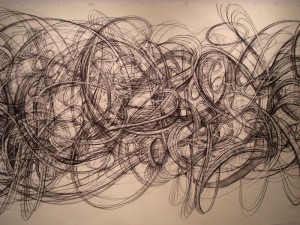
Jennifer Wroblewski’s solo show, “New Monuments to the AntiConcept,” is on view at A.I.R. Gallery, Brooklyn, NY, through March 1. Detail: "Slave to Love," charcoal on paper, 72 x 190 inches.
Jen Wroblewski: Mother/ Mother
Jennifer Wroblewski was originally discouraged when older female artists she knew intimated that her pregnancy would adversely affect her career. Rather than accept the projected consequences of professional indifference and potential dismissal, Wroblewski decided to curate an exhibition tentatively titled Mother/Mother that would explore ideas garnered from the process of parenting. With a couple of solo shows in the works and an A.I.R. Gallery Fellowship for support, Wroblewski hopes to turn what used to be seen as the “harbinger of the end of a woman’s career” into a auspicious beginning. The show, which will feature work by Julie Heffernan, Monica Bock, Sharon Thomas, and Dana Lee, is scheduled for Fall 2009.
Sharon Butler maintains an art blog, Two Coats of Paint. Her paintings can be seen in Blogpix, an exhibition curated by art bloggers Joanne Mattera, Libby Rosof, Roberta Fallon, and Hrag Vartanian at Platform Project Space, New York, NY, March 5-March 28. The show’s organizer is Olympia Lampert.




Pingback: role of art : Museumist
Pingback: News Room :: Art in the 21st Century- Expanding the Artist’s Role
Pingback: They Are the World | Art21 Magazine